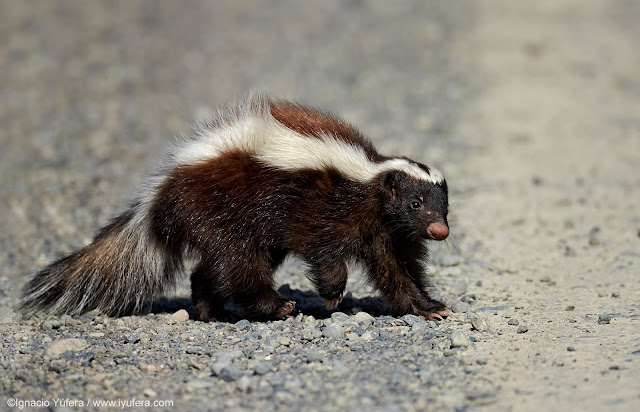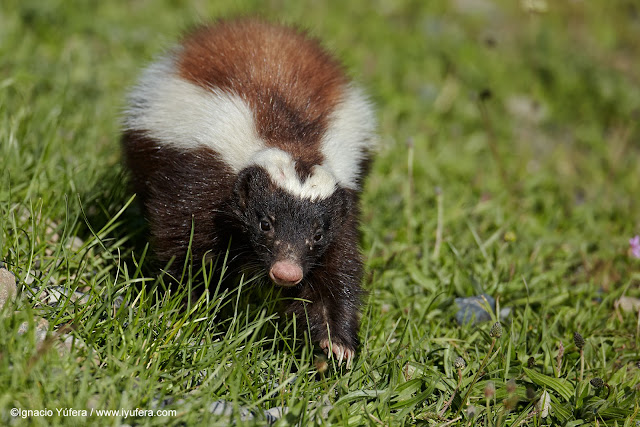In November 2012 I traveled to Torres del Paine National Park in South Chile, with the main goal of seeing and photographing pumas. I organized the trip through Trogon Tours, a company specialized in South American birding and wildlife trips, owned and managed by my friend Luis Segura, who was my guide throughout the trip. Luis secured the services of José Vargas, a local tracker who has lived and worked in the park all his life, and who probably knows more about Patagonian pumas than anyone else.
Patagonian Hog-nosed Skunk
(Conepatus humboldtii)
We spent every early morning and late afternoon searching for pumas. One morning, just before sunrise, we were driving the one dirt road that traverses the park, when some 100 meters in front of us we saw a puma running along the road, and there seemed to be something running after it. For a moment, it seemed that the dim pre-dawn light was playing tricks on us, but as we drove closer there was no mistake: a Patagonian Hog-nosed skunk was chasing our puma. As we got closer, the puma sprinted across the road and disappeared behind a ridge. He looked like a young male, an almost fully-grown cub really, probably belonging to a family we had been watching for a couple of days in the area. The skunk stayed by the road. We left the car and started walking after the puma, hoping to get enough for some photos, with no success; after a long hike we lost it and returned to the car. By then it was mid-morning, and to my surprise the skunk was still there, minding its own business, digging for worms and grubs among the wet green grass.
The skunk crossing the dirt road, the one chance I had of a clean, full-body shot.
A few days earlier I had seen a skunk in the park, a shy young animal that ran away as soon as I tried to approach it. Judging from the rusty color of his coat, this one was an older guy, more experienced and confident in his chemical dissuading abilities, and didn’t seem to mind our presence at all. I asked José if he could try and make it move towards me, so I’d have him under better light. As soon as he noticed José getting closer, the skunk raised his head and confronted us, grunting and huffing his annoyance. It was hard not to laugh: the guy was the size of a small cat, and was confidently confronting three grown men, totally unafraid.
We kept a respectful distance and gave him his space, and he continued foraging in a nearby meadow. He kept his head low to the ground, so it was difficult to get a good shot of his head and his unique snout. At one point I sat on the ground, waiting for him to appear from behind a bush for a low shot, and to my surprise he walked briskly towards me until he was less than a meter away, at one point almost touching my feet with his nose. José looked concerned, to say the least: “Por favor, Ignacio, ¡no te muevas! ¡Que no se asuste!”, even though the chances of the little fellow being afraid of anything seemed quite remote. The prospect of having to drive me in his car after being skunk-sprayed must have been horrifying, and rightly so. Luckily, the skunk chose not to use his weapon of mass destruction on me, and just continued his mid-morning stroll; after chasing a puma away, he clearly wasn’t going to be bothered by some annoying photographer. You could almost hear him humming “La Cucaracha”. And he did give me some close-up shots of his nose that almost made up for losing the runaway puma…
A bit too close for comfort…
Patagonian (or Humboldt’s) hog-nosed skunks (Conepatus humboldtii) are rather common in Torres del Paine. Tough and adaptable, they eat almost anything they can find or catch, and prefer open grassland with small woodland patches, pretty much the kind of habitat favored by the puma. Both species must cross their paths relatively often, and if the puma is a fully grown, experienced and hungry adult, one can imagine that the outcome can be quite different; however, so far this old character had proved quite capable of holding his ground.
You can see the more photographs from the trip at my website: www.iyufera.com
Ignacio Yúfera
Ignacio Yúfera is a Spanish photographer and business manager, living between Madrid and Calgary with his Canadian wife, Margaret. He is the founder and President of the Emberiza Fund (www.emberiza.org), an organization dedicated to small-scale projects in conservation. The Fund aims its efforts towards species and habitats that escape the media’s attention and are often out of the scope of larger conservation organizations.
- Web |
- More Posts(4)





Leave a Reply